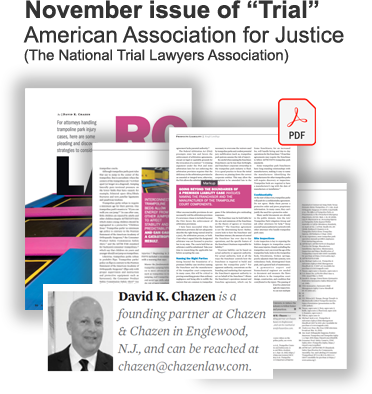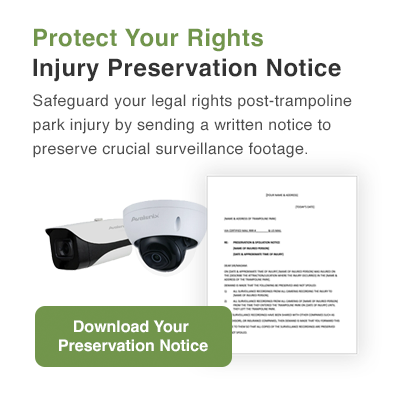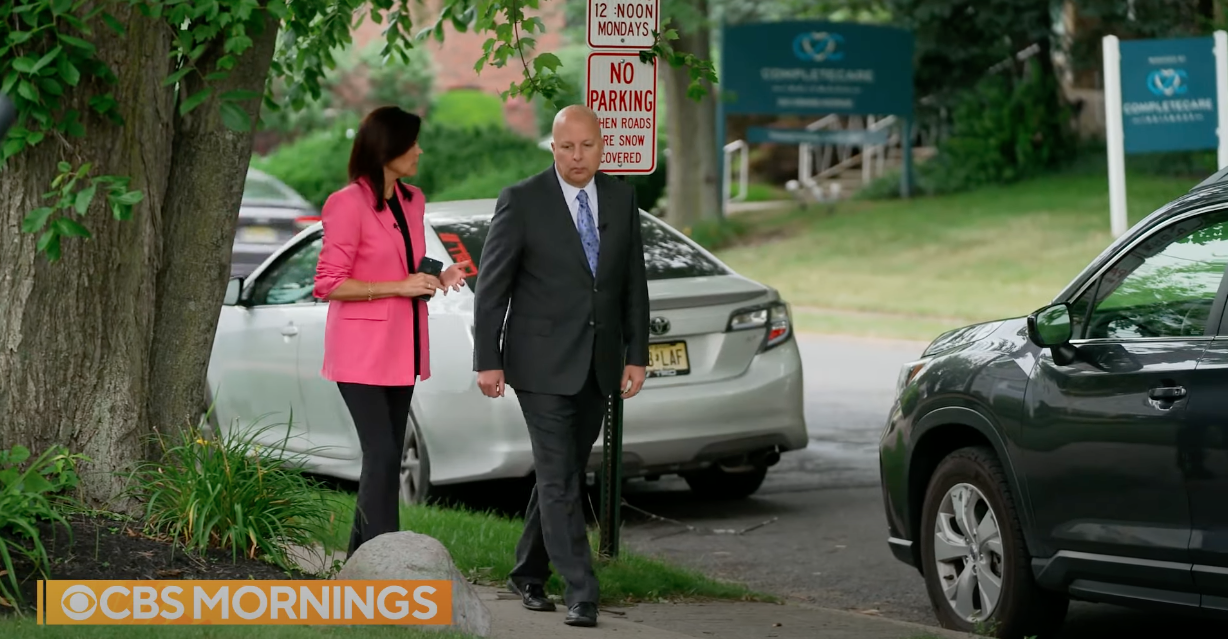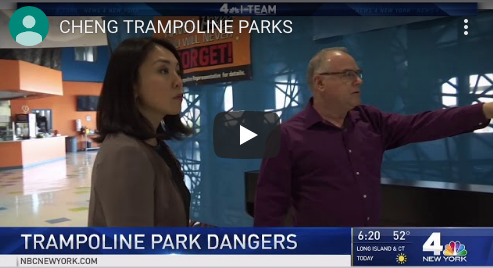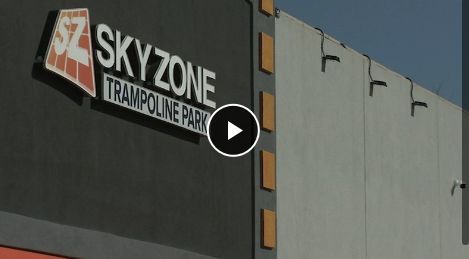WE ARE EXPERIENCED IN TRAMPOLINE PARK INJURY CASES.

Trampoline Park Injury & Accident Lawyer
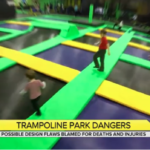
We are a New Jersey law firm that handles trampoline park injury cases in New Jersey and networks with attorneys nationwide because of our knowledge and experience in trampoline park injury litigation.
In approximately 2005 trampoline parks reemerged with Sky Zone and Sky High leading the way. With history repeating itself, trampoline park deaths and injuries returned. As Sky Zone and other trampoline parks added locations, the number of persons ending up in ERs and being admitted to hospitals soared. So much so, that multiple doctor’s groups around the world have taken notice and published injury studies to raise the alarm that trampoline parks are dangerous.
There are close to a 1,000 trampoline parks in the U.S. with new locations opening all the time. The names may differ, but the hidden dangers are present in every trampoline park. Deaths and injuries have not prompted trampoline parks to make themselves safer. It would be a start if trampoline parks set a minimum age of six (6) years old, ban flips, separate the trampolines, and offer qualified skill assessment, progressive instruction, and supervision. Trampoline parks have rejected these suggestions because it would hurt revenue. Trampoline parks say that as a recreational facility they have no duty to follow these well-known safety practices and it up to the consumer not to get hurt. Even worse, as trampoline parks evolve, they put aside safety concerns and compete for customers by introducing more and more attractions, such as performance trampolines, dodgeball, basketball dunk, basketball courts, climbing walls, zip lines, rotating beams, foam pits, air bags, warp walls, ninja courses and the like, which crowd the trampoline beds, distract the jumper from landing safely, or require advanced maneuvers, causing deaths and injuries to climb at an even faster rate.
TRAMPOLINE PARK SAFETY
- Why aren’t trampoline parks safe? The average trampoline park customer is unaware of the hidden dangers inherent in trampoline park design, operation, and features. These include:
- Children 6 and younger should not be allowed on trampolines. Who says so? Medical groups, the Consumer Product Safety Commission (CPSC), the warnings on backyard/consumer trampolines. What is the policy of trampoline parks, such as Sky Zone? – “If you can walk you can jump.” (My youngest clients are 1 and 2 year-olds with fractured legs and a 4-year-old with a fractured femur.) Children are the most susceptible to heartbreaking injuries.
- Trampolines are supposed to be used as a single stand-alone unit where the jumper walks to (and from) the center, only jumps vertically, and can easily stop by bending their knees. Trampoline parks misuse trampolines in their “trampoline court” design that allows jumpers to jump laterally from trampoline-to-trampoline, or from platforms onto trampolines leading to a loss of control and injuries from the side-ways or torsional pressures on bones and joints from a lateral jump landing.
- Trampoline parks interconnect smaller trampolines into what they call a “trampoline court” that looks like a large chess board. The small trampolines do not have the same amount of bounce as a standard size trampoline and are less forgiving upon impact. Fractured wrists, ankles, and torn ligaments in the knees are not uncommon. Children are encouraged to jump from square to square and expected to jump in the center (a distance of about 7 to 9 feet), and land on two (2) feet. This is not possible. Injuries occur when the children land more on one (1) foot, or on the harder outer portions of the trampoline bed, or on the minimally padded frames and springs.
- The trampoline beds at trampoline parks are thick, heavy , and stiff, surrounded by 100 heavy springs, and sealed creating a diaphragm effect, and are more powerful when compared to the less tensioned gymnastic, and backyard trampolines. The center to the sides of the trampoline beds varies in tension, and the trampoline beds recoil with tremendous bone breaking speed/force. (Site inspections by my bio-mechanical engineers have measured the force) My 1 and 2 year and 4-year-old clients’ legs were fractured by the force of the trampoline bed returning to its static position.
- The trampolines are interconnected, and jumpers are continually at risk from other jumpers who may jump on the same trampoline and cause a collision or “double jump” (where the recoil or snap back of the trampoline bed causes injuries to the smaller jumper); and energy transfers occur from jumpers on other trampolines in the “trampoline court” making the trampoline surfaces unpredictable. The trampoline-to-trampoline energy transfers in a “trampoline court” are higher at Sky Zone trampoline parks because they choose to use a chain-link system instead of metal frame structure to support the trampoline beds in a “trampoline court”.
- Even more irresponsible, trampoline parks combine trampoline use with other activities such as dodgeball and wipe out (the wipe out attraction has been banned in multiple states because of high injury rates, but the trampoline park companies continue to operate the wipe out attraction in other states) where multiple persons jump together and create ultrahazardous scenarios that more and more frequently result in devastating injuries. The dangerous designs and operations of the trampoline park industry continue despite having been repeatedly warned for more than a decade by gymnastics and safety experts of the foreseeable harm to the uninformed public.
- The trampoline parks market themselves to children, hosting birthday parties, camps and “Glow Nights” when jumpers glow under black lights and lasers in darkened facilities. Common sense dictates that good lighting is necessary for depth perception, awareness of surroundings, and to jump safely. “Glow Nights” is another money-making gimmick for trampoline parks that demonstrates the industry’s lack of concern for safety.
- Trampoline parks purposely offer no skill assessment or instruction. Their employees are prohibited from offering any help on how to jump. As far as the trampoline parks are concerned, it is up to the jumper to know how to jump safely within their skill level. The typical trampoline park jumper has no knowledge of how to perform basic skills, let alone what maneuvers are beyond their skill level. This is especially true for children that not only lack knowledge, but also have not yet matured physically, matured mentally, and developed good judgment.
- ADVANCED SKILLS – Advanced trampoline jumping maneuvers are especially dangerous for the non-athletic and/or untrained jumper. The high risk of injury when exceeding one’s skill level is cautioned against by the USAG, ASTM, CPSC, and even the IATP in its never published/self-censored 2015 Risk Management Manual.
- ADVANCED SKILLS (As defined by ASTM F2970):
Aerial Maneuver – Inverting the body (flips/somersaults), risk of death or paralysis from landing on head/neck. Many trampoline parks encourage users to perform flips, even though one manufacturer/designer of the trampoline parks has said the trampoline beds are too small to safely perform flips. A manufacturer of trampoline park trampoline beds warns in its operating manual that flips are not allowed during dodgeball games. Medical groups, the Consumer Product Safety Commission (CPSC), the warnings on backyard/consumer trampolines, all recommend that flips not be performed on trampolines in a recreational setting. Flips should only be attempted after being properly trained by a professional gymnastics coach. Tragic cases of death and quadriplegia have resulted from people attempting flips at trampoline parks. - Jumping Horizontally from Trampoline to Trampoline – The trampoline is propelling a jumper sideways making it difficult to jump in the center of the trampoline and control landings . . . Resulting in off balance landings . . . Resulting in contacting harder areas of trampoline bed around the perimeter. . . Resulting in contacting the edge of the padding, or landing on the thin pad covering springs, chains, steel frames, steel posts . . . Causing spontaneous fractures of feet, ankles, leg bones, hip joints and the tearing of ligaments, tendons and joints.
- Jumping Off of Sidewalls – The angled sidewall that changes the axis of the body position makes it difficult to land safely, equally on two feet, on the adjacent horizontal trampoline.
SKY ZONE TRAMPOLINE PARK
Sky Zone is by far the largest player in the trampoline park industry. In 2012, Sky Zone led the way in creating the ASTM F2970 trampoline park standards, which was controlled by trampoline park industry voters, and offers little protection to the public. In 2013, Sky Zone was a founding member of the International Association of Trampoline Parks (IATP), the trampoline park industry trade organization. The IATP has suppressed safety improvements that could hurt trampoline park revenues. The IATP issues press releases how safety is a priority when the trampoline park industry receives media attention after a death or serious injury. In December 2017 Sky Zone was acquired by Circustrix Holdings, LLC and is now part of a private equity company, that includes Circustrix, Rockin’ Jump, and Defy trampoline parks, which are all owned by Trampoline Acquisition Parent Holdings, LLC and Palladium Equity Partners, LLC. Chances are there is a Sky Zone or sister trampoline park near you.
SKY ZONE WAIVER AGREEMENT
Sky Zone Waiver – If you enter a Sky Zone, its sister companies (or any trampoline park for that matter), you have to sign a waiver of your right to make a claim against Sky Zone for personal injuries. The waiver’s enforceability depends on whether a minor or adult is injured and the laws of the state where the injury occurred. Sky Zone knows full well how dangerous these activities are and requires parents to sign waivers before the children can enter. The waivers speak plainly about death, paralysis, and broken bones … and they are not kidding. On the other hand, their marketing suggests family fun, birthday parties, and showcases advanced gymnastics skills that require training before they can be attempted safely. What they don’t tell you about are the hidden dangers and that, in many cases, they don’t follow industry standards and guidelines, or for that matter their own safety rules. The waivers that parents sign for their children are illegal and unenforceable in New Jersey and many other states. See Hojnowski v. Vans Skate Park, 187 N.J. (2006). The waivers that adults sign for themselves are unenforceable in New Jersey and many other states if “gross negligence” can be proven. See Stelluti v. Casapenn Enterprises, LLC, 203 N.J. 286 (2010). The indemnification clause that requires reimbursement of whatever the claim may cost the trampoline park is unenforceable in New Jersey and many other states. See Dare v. Free Fall Adventures, Inc., 349 N.J. Super. 205 (App. Div. 2002), cert. den. 174 N.J. 43 (2002). (On July 12, 2021, our proofs defeated Sky Zone’s Motion for Summary Judgment to dismiss the “Gross Negligence” Count in a Complaint in a minor’s NJ case; On August 31, 2021, in a Sky Zone case, our proofs convinced the Court to find a “reasonable evidentiary basis” to permit the Complaint to be amended to allege punitive damages in an adult’s out-of-state case; On October 22, 2021, our proofs defeated a Motion for Summary Judgment by another trampoline park company based on the waiver in an adult’s NJ case.)
Sky Zone Arbitration – Besides the waiver, the next thing the agreement says is that you must arbitrate your personal injury claim. Why does Sky Zone choose arbitration you ask? Unlike suing in Court, in arbitration:
- Sky Zone picks the arbitration company and the rules by which the arbitration is conducted;
- An arbitrator, not a jury decides the case;
- The arbitration filings and proceedings are secret and not accessible to the media or other injured customers;
- Decisions by the Arbitrator, even if wrong, are not appealable, unless you can prove some corrupt behavior;
- Chances are that any decision, award or settlement will be subject to a NDA (Non-disclosure Agreement) or Order.
Over the years, Sky Zone periodically changed the arbitration clause in the waiver. Enforcement of the arbitration clause by the courts has depended on its language. In the Fall of 2021, Sky Zone and its sister companies started using a new clause which requires: (1) negotiation; (2) mediation; and (3) “non-binding” arbitration, before a lawsuit may be filed. In newer cases, this firm has filed lawsuits and will litigate any effort to enforce this clause as a blatant attempt to infringe on the constitutional right to file a lawsuit and resolve civil disputes.
TRAMPOLINE PARKS’ ARBITRATION CLAUSES
Many trampoline park companies name an arbitration company, such as the American Arbitration Association (AAA), without having the contract pre-approved by AAA. Some specify that the arbitration company’s “commercial rules”, not the “consumer rules”, apply. If arbitrating by the “commercial rules” was enforceable, it would mean that the costs and fees to be paid by the injured party would skyrocket. Fortunately, the arbitration companies do not allow this and will require that the “consumer rules” apply to trampoline park injury cases. This is another effort by some trampoline companies to mislead and intimidate injured consumers from pursuing a claim.
CONCLUSION
In short, waivers and arbitration clauses are effective methods of discouraging claims and keeping the public in the dark when it comes to the high risk of serious injury at trampoline parks. Waivers and Arbitration provisions are not always worth the paper or screen they are written on. KNOW YOUR RIGHTS! CONSULT WITH AN ATTORNEY! [This office has had some success in voiding the Sky Zone arbitration provision. Defina v. Go Ahead & Jump 1, LLC, No. A-1371-15T3 (N.J. Super. App. Div. 2016); Defina v. Go Ahead & Jump 1, LLC, No. A-1861-17T (N.J. Super. App. Div. 2018); Defina v. Go Ahead & Jump 1, LLC, 200 A.3d 920 (N.J. 2019) (remand); Defina v. Go Ahead & Jump 1, LLC, No. A-1371-15T3, (N.J. Super. App. Div. 2019).]
Contact us for your Free Consultation
Contact us today to schedule your confidential, free consultation. Call (201) 567-5500 or fill out the form below.
David Chazen in the Press
CBS Mornings News Story: Study shows trampoline parks more dangerous than home trampolines
NBC News Story: Trampoline Park Dangers
Jumping into the ER: Safety experts warn of dangers at indoor trampoline parks
Trampoline parks jump in popularity, but expert warns of “catastrophic injuries”
The shocking dangers of kids play zones everywhere
What clients are saying about Chazen & Chazen
Need more info? Check out our most frequently asked questions.
What are Trampolines
A trampoline is a training device and a gymnastics apparatus that requires caution. Certified gymnastic instructors use skill assessment and progressive learning programs so that basic trampoline skills are mastered before more advanced skills are even attempted. In gymnastics, trampoline safety is a priority and strict rules are followed to prevent injury.
Invention of Trampoline
The trampoline was invented by George Nissen after World War II as a training device for pilots. The trampoline was adopted by the gymnastics world and was accorded respect as a powerful apparatus that can kill, paralyze or maim if not used properly. For more than seventy (70) years the gymnastic community has adhered to rules for trampolines that include:
- One person on a trampoline;
- No jumping onto or off of a trampoline;
- Skill assessment with progressive learning from a certified instructor so that basic skills are mastered before more advanced skills, such as aerial maneuvers, are attempted. [Instructors, not jumpers, decide what maneuvers jumpers are ready to perform].
Backyard Trampolines / Consumer Trampolines
Safety rules for backyard trampolines have existed for more than forty-five (45) years that include:
- Use in a well-lit area;
- The trampoline surface be horizontal to the floor;
- Not recommended for children under 6 years of age;
- DO NOT attempt or allow somersaults. Landing on the head or neck can cause serious injury, paralysis or death, even when landing in the middle of the bed;
- One person on a trampoline at a time. Use by more than one person at the same time can cause serious injury;
- Climb on and off the trampoline. Do not use the trampoline as a springboard;
- Bounce in the center of the bed;
- Use trampoline only with mature, knowledgeable supervision;
- Avoid bouncing when tired. Keep turns short;
- Learn fundamental bounces and body positions thoroughly before trying more advanced skills;
- For information concerning skill training, contact a certified trampoline instructor.
Contact us for your Free Consultation
Contact us today to schedule your confidential, free consultation. Call (201) 567-5500 or fill out the form below.
Attorneys in other states work with us because of our knowledge
when it comes to Trampoline Park Injuries.

Attorney Advertisement: Prior results do not guarantee similar outcomes.
Address
Chazen & Chazen, LLC
346 Grand Avenue
Englewood, New Jersey 07631
Connect
Phone: (201) 567-5500
Fax: (201) 567-4282
24 Hour Service:
Cell No. (201) 888 - 5800
during non office hours
Email: chazen@chazenlaw.com

